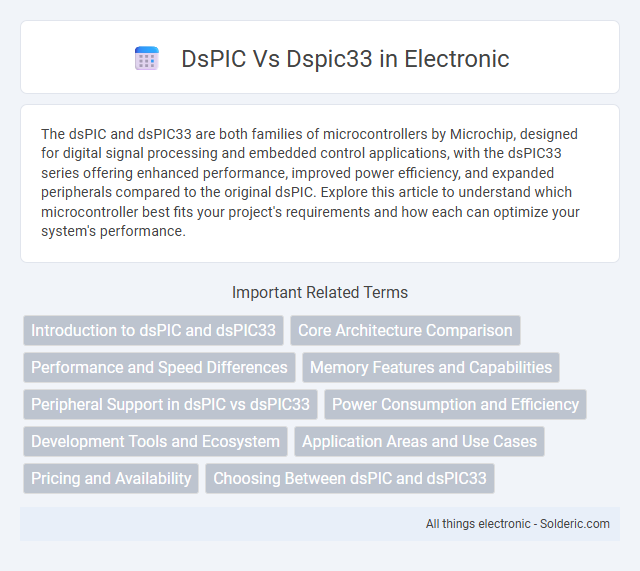The dsPIC and dsPIC33 are both families of microcontrollers by Microchip, designed for digital signal processing and embedded control applications, with the dsPIC33 series offering enhanced performance, improved power efficiency, and expanded peripherals compared to the original dsPIC. Explore this article to understand which microcontroller best fits your project's requirements and how each can optimize your system's performance.
Comparison Table
| Feature | dsPIC (Generic) | dsPIC33 |
|---|---|---|
| Architecture | 16-bit Digital Signal Controller | Enhanced 16-bit Digital Signal Controller |
| Core | dsPIC30 Core | dsPIC33 Core with improved performance |
| Clock Speed | Up to 40 MIPS | Up to 70 MIPS |
| Memory | Flash up to 144 KB | Flash up to 512 KB |
| Peripherals | Basic peripherals, ADC, PWM, UART | Enhanced peripherals, ADC, PWM, UART, CAN, USB |
| Power Efficiency | Standard | Improved low power modes |
| Applications | General DSP, Motor Control | Advanced Motor Control, Industrial Automation, Audio Processing |
| Package Options | Wide range including DIP, QFN | Wide range including QFN, TQFP |
Introduction to dsPIC and dsPIC33
dsPIC is a family of microcontrollers from Microchip Technology that combines a 16-bit CPU with digital signal processing (DSP) capabilities, designed for real-time control applications. The dsPIC33 series represents an enhanced generation within this family, featuring improved performance, a more efficient architecture, and lower power consumption while maintaining compatibility with existing dsPIC devices. With advanced peripherals and higher computational speed, dsPIC33 microcontrollers are ideal for industrial automation, motor control, and audio processing tasks.
Core Architecture Comparison
The dsPIC33 microcontrollers feature a 16-bit architecture combining a modified Harvard architecture with DSP-enhanced core instructions optimized for real-time digital signal processing. In contrast, the original dsPIC series typically refers to dsPIC30 devices, which also use a 16-bit core but with older generation PIC architectures offering fewer enhancements in speed and computational efficiency. Your projects benefit from dsPIC33's improved pipeline and advanced instruction set, delivering faster processing and better performance in complex embedded applications.
Performance and Speed Differences
The dsPIC33 family offers enhanced performance and speed compared to earlier dsPIC devices, featuring improved MIPS (Million Instructions Per Second) rates and faster clock speeds. With core enhancements and optimized instruction sets, dsPIC33 microcontrollers deliver higher processing throughput ideal for complex digital signal processing tasks. Your applications benefit from reduced execution times and greater efficiency when leveraging dsPIC33's advanced architecture.
Memory Features and Capabilities
dsPIC33 microcontrollers offer enhanced memory features compared to older dsPIC models, including up to 512KB of Flash program memory and 96KB of RAM, supporting complex digital signal processing tasks. The dsPIC33 series integrates advanced memory management capabilities such as ECC (Error Correction Code) for Flash memory and flexible memory partitioning, improving reliability and application-specific customization. These features enable dsPIC33 devices to efficiently handle larger data sets and complex algorithms, making them ideal for high-performance embedded applications.
Peripheral Support in dsPIC vs dsPIC33
The dsPIC and dsPIC33 microcontrollers both offer extensive peripheral support, but dsPIC33 devices provide enhanced integration with advanced peripherals such as CAN, USB, and multiple communication interfaces tailored for complex applications. Your choice may depend on the need for higher peripheral flexibility, with dsPIC33 typically featuring more robust PWM modules, ADC channels, and timer options compared to legacy dsPIC families. Peripheral compatibility and scalability in dsPIC33 make it ideal for demanding control and signal processing tasks requiring precise and diverse hardware support.
Power Consumption and Efficiency
The dsPIC33 family offers enhanced power consumption features with advanced Sleep modes and low-power peripherals designed for energy-efficient embedded applications. Compared to earlier dsPIC models, dsPIC33 microcontrollers optimize efficiency through improved CPU performance per clock cycle and integrated power management units. Your choice between dsPIC and dsPIC33 should consider these efficiency gains, especially for battery-powered or energy-critical devices.
Development Tools and Ecosystem
The dsPIC and dsPIC33 families share compatibility with Microchip's MPLAB X IDE and MPLAB Code Configurator, offering seamless integration for embedded development. Both support powerful debugging and simulation tools such as MPLAB ICD 4 and REAL ICE, enhancing code validation and performance tuning. The extensive ecosystem includes libraries, middleware, and application-specific solutions that streamline development workflows for real-time digital signal processing applications.
Application Areas and Use Cases
The dsPIC33 microcontrollers are widely used in advanced motor control, digital power conversion, and automotive applications due to their high-performance 16-bit architecture and integrated DSP capabilities. In contrast, the broader dsPIC family includes variants optimized for applications such as audio processing, industrial automation, and embedded control where real-time signal processing and precise computation are crucial. Both dsPIC and dsPIC33 devices support complex algorithms, but dsPIC33 MCUs offer enhanced features and peripherals tailored for mixed-signal processing and high-reliability embedded systems.
Pricing and Availability
dsPIC microcontrollers are generally priced competitively, with the dsPIC33 series offering a broader range of options suited for more complex applications, which can affect cost slightly. The dsPIC33 variants often come with enhanced features, leading to varied pricing tiers depending on memory size and processing speed. Your choice between dsPIC and dsPIC33 should consider both the specific performance needs and the availability through distributors, as dsPIC33 chips tend to be more readily stocked due to their popularity in advanced embedded systems.
Choosing Between dsPIC and dsPIC33
Choosing between dsPIC and dsPIC33 hinges on the application's processing power and peripheral requirements, where dsPIC33 devices offer enhanced performance with 16-bit architecture and higher integration for complex control tasks. dsPIC33 microcontrollers provide improved digital signal processing capabilities, lower power consumption, and expanded memory options compared to earlier dsPIC models, making them ideal for advanced motor control and audio processing. Selecting dsPIC33 over traditional dsPIC variants ensures access to a broader ecosystem of development tools and software libraries tailored for modern embedded system challenges.
dsPIC vs dspic33 Infographic

 solderic.com
solderic.com